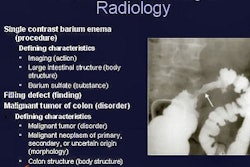LAS VEGAS - The competitive imaging landscape in the U.S. today requires radiology practices to position themselves where the future is moving -- not reacting to where the market is currently. This means streamlining the workforce, operations, and processes, both incrementally and in broad strokes.
Healthcare information technology (IT) can provide the necessary tools to realize a competitive advantage in the crowded imaging marketplace, according to a presentation at the Radiology Business Management Association (RBMA) radiology summit.
"Develop ambitious, stretch goals that are delivered quickly in small steps, each moving toward the ultimate goal, building on previous success," said Dr. Murray Reicher, chairman of imaging center operator Radiology Service Partners (RSP) of San Diego and chairman of RIS and PACS developer DR Systems, also in San Diego.
Reicher shared his thoughts on using information technologies to enhance a competitive advantage with RBMA attendees earlier this week.
Customer focus
Reicher believes that a Web-enabled PC is becoming the primary communication tool of both referring physicians and their staff. As such, radiology practices that can deliver medical imaging results (including images, reports, and audio) along with scheduling, utilization guidance, and feedback to their referring physicians' PCs will capture and retain this customer base.
"If you own the (information, scheduling, and viewing) application sitting on their desktop, that's a tremendous advantage to you," he said.
RSP holds that the most important customer for its multicenter imaging practice is the referring physician. Reicher said his group has demonstrated that these physicians require faster, more accurate diagnoses, and delivery of information tailored to their individual needs.
"Systems need to be customized to meet the requirements of the individual referring physician so that when a report is completed, it goes to the right physician in the right format," he said.
Reicher believes that achieving this goal requires a practice to improve the clarity of its information exchange and expedite the reporting of results. He is a strong proponent of structured reporting, as his group's market research indicates that this is what his referring physicians desire.
"Referring physicians want short, concise, list-based reports, not prose reports that differ from radiologist to radiologist," he said.
The group found that in addition to timely, accurate structured reports, its referring physicians also wanted easy scheduling and information input, as well as access to medical imaging specialists and Web-accessible guidance. In response, RSP enabled Web-based scheduling, radiologist query capabilities, and delivered image-management tools to its customers.
"The heavy-hitting CT and MR referrers want everything the radiologist has, and you should give it to them," Reicher said.
He said that the result has been happier referring doctors with easier exam scheduling, which has resulted in more business for the group.
Reicher also stressed the need for a practice to adopt integrated information systems (IS), rather than individual IS components for radiology.
"I would contend that in our industry, PACS (as a standalone system) is dead," he said. "I'm a PACS provider, but RIS and PACS and supporting dictation systems are rapidly consolidating into one system. The one specialty product information system for radiology, I don't see that surviving much beyond another five years."
Seven-step program
Once a radiology practice has made the decision to adopt an integrated IT strategy, Reicher offered seven steps to make the implementation a success.
Make a firm commitment to the IT vision. This requires setting tangible goals and firm deadlines. Reicher advised that a group should create a mission statement and have everyone sign it.
Designate and empower leaders. These should be champions of the project representing the practice physicians, administrators, technologists, and IT group. Responsibility and accountability for the project elements will need to be identified and assigned.
Prepare the group's customers for the forthcoming change. "Involve your referring-physician customers early so that they don't view the new technology as a withdrawal of services," Reicher advised.
Begin full utilization of the technology from the beginning of the implementation. Reicher advocates jettisoning the old system as early as possible and beginning training immediately. Job descriptions and employee standards will also need to be rewritten to incorporate the new technology and processes.
As part of this step, he suggests making staff changes unambiguously and as early as possible. If adopting the technology is expected to result in downsizing (such as film library employees, schedulers, or transcriptionists), he believes that those employees should be let go the day before its implementation. In this manner, the staff will be forced to utilize the technology and systems to pick up the workload.
Train staff on how to communicate the changes internally and externally. Reicher advised that problems should be channeled to the appropriate group's champion immediately, and that a script should be developed in response to questions from the practice's customers.
Change the facility's workflow. This requires diagramming current workflows and eliminating all tasks that do not add value to the practice. In addition, workflows should be continuously reassessed and restreamlined.
Measure, reap, and market the benefits of the new systems. "You want a system that provides an odometer of every clinical and business event in your practice," Reicher said. "If you measure it, it will improve."
By Jonathan S. Batchelor
AuntMinnie.com staff writer
June 9, 2005
Related Reading
Flexibility crucial for bringing PACS to the ED, OR, and ICU, June 7, 2005
PDAs show promise for RIS/PACS portability, May 13, 2005
PACS improves care, builds interhospital relationships, March 14, 2005
Web-based workflow and reporting systems keep imaging on track, March 10, 2005
PACS succeeds clinically, financially for IDNs, February 15, 2005
Copyright © 2005 AuntMinnie.com



















